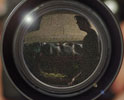

Low grade RG59 coaxial cable affects picture quality on CCTV systems.
RG59 coaxial cable commonly used in CCTV systems, electrically connects the CCTV camera signal to video monitors and recording equipment. Typically, cable runs of RG59 can span distances of up to 250 and 300 metres from camera to monitor. This effectively carries the video signals from cameras to monitors with minimal attenuation loss and no noticeable picture distortion.
In recent months however, a low quality brand of coaxial cable has flooded the South African CCTV market under the guise of being authentic RG59 mil standard CCTV cable, traditionally being installed in the CCTV industry.
The effects of this cable on the camera signal are quite obvious when runs of 100 metres or more are used. These effects include:
* Picture blurring or loss of detail.
* Camera appears to be out of focus.
* Picture on monitor loses synchronisation and appears as if there is an earth potential difference problem between camera and monitor.
The cause of the problem is the high resistance of the centre core conductor of the coaxial cable and the inherent capacitive properties of the cable working together to create an RC time constant smoothing effect which destroys the integrity of the synchronisation signals of a standard composite video signal. The distortion of the synchronisation signal by the cable causes the picture to 'rip' simulating a difference earth potential problem or similar to a monitor losing synchronisation. The RC combination of the poor quality cable also negatively affects the high frequency components of the video signal which causes loss of picture detail or resolution which appears as if the camera is out of focus.
The low quality cable can be detected in a number of different ways:
* Firstly, if you have some of the problems mentioned above, then the coaxial cable is the first thing to check.
* Most coaxial cables have a specification or manufacturers details printed on the cable.
In future we hope to record details of other low-grade cables so that installers can avoid the use of these problematic low quality cables.
* By far the most effective method of checking for the poor quality cable is to measure the centre core DC resistance with a standard Fluke multimeter. Over a 100-metre length of cable the resistance of the centre core should be less than 7 Ω per 100 metres for good cable. This complies to the RG59 Standard. A measurement of 15 Ω per 100 metres and higher to say 30 Ω per 100 metres indicates a poor quality cable. It is this high DC resistance of the cable in conjunction with the cable characteristic capacitance and as well as being directly proportional to the increased high frequency component of the video signal that causes picture and synchronisation distortion.
* Good quality cable should have at least a 0,6 mm diameter centre solid copper conductor. The poor quality cable has a thinner centre conductor, which is an aluminium composite copper clad centre core. It can be identified by scraping it with a side cutter thus removing the copper cladding and exposing the silvery-coloured shiny inner conductor material.
Ultimately the CCTV installers and reputable suppliers to the CCTV industry need to rid the market of this poor quality cable as this cable has resulted in below specification results from the CCTV system. Inevitably, this poor quality cable has to be removed and replaced with real RG59 resulting in huge financial losses for CCTV installers.
For more information contact Cliff Rose, Modular Communications SA, +27 (0)41 364 2653, [email protected], www.modular.co.za
| Tel: | +27 41 364 2653 |
| Email: | [email protected] |
| www: | www.modular.co.za |
| Articles: | More information and articles about Modular Communications |

© Technews Publishing (Pty) Ltd. | All Rights Reserved.